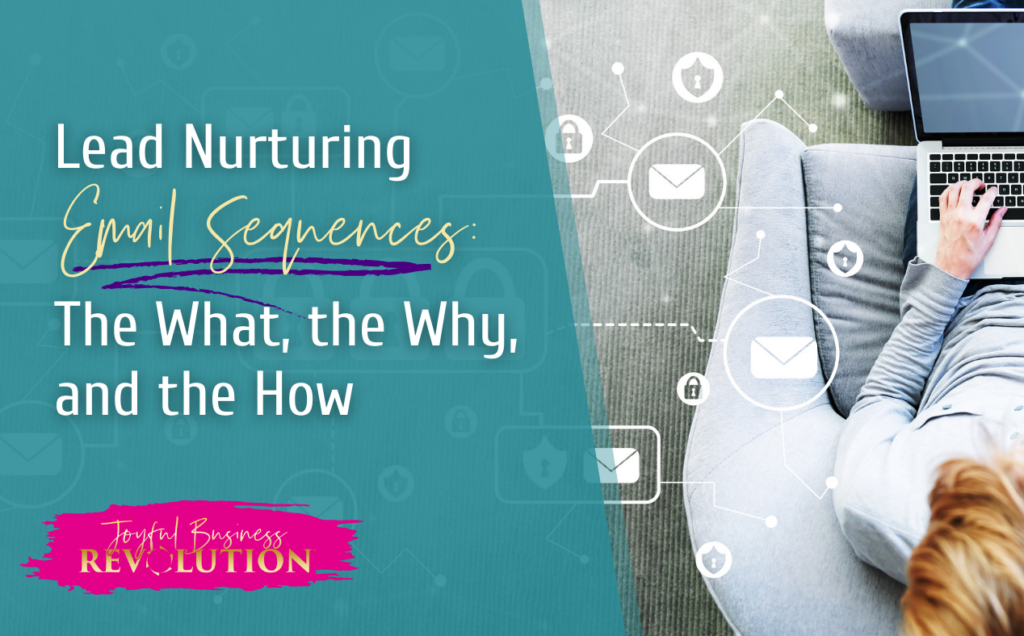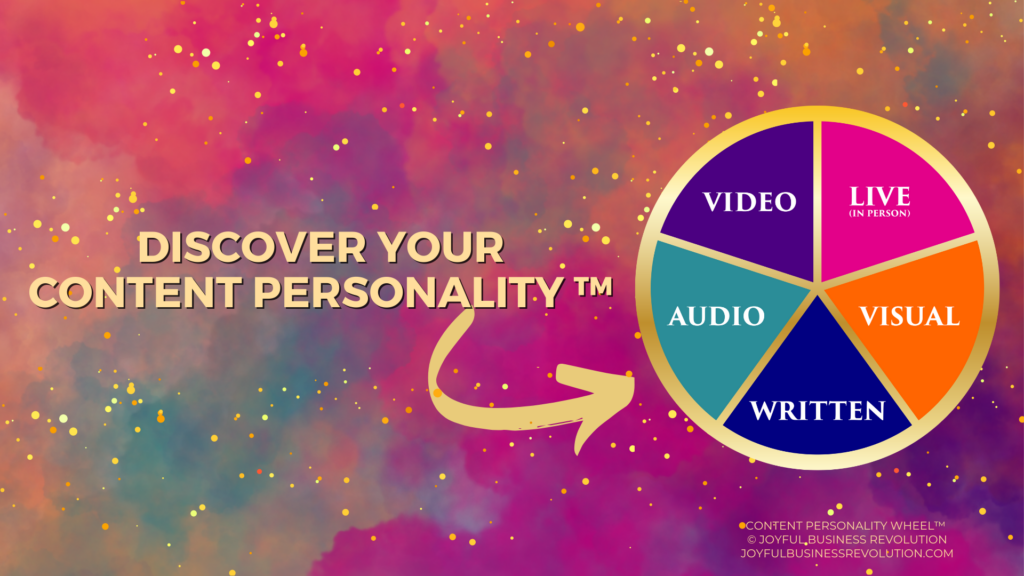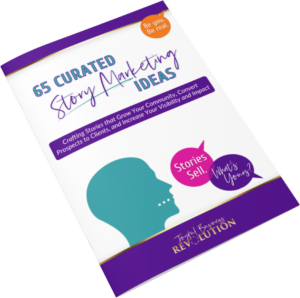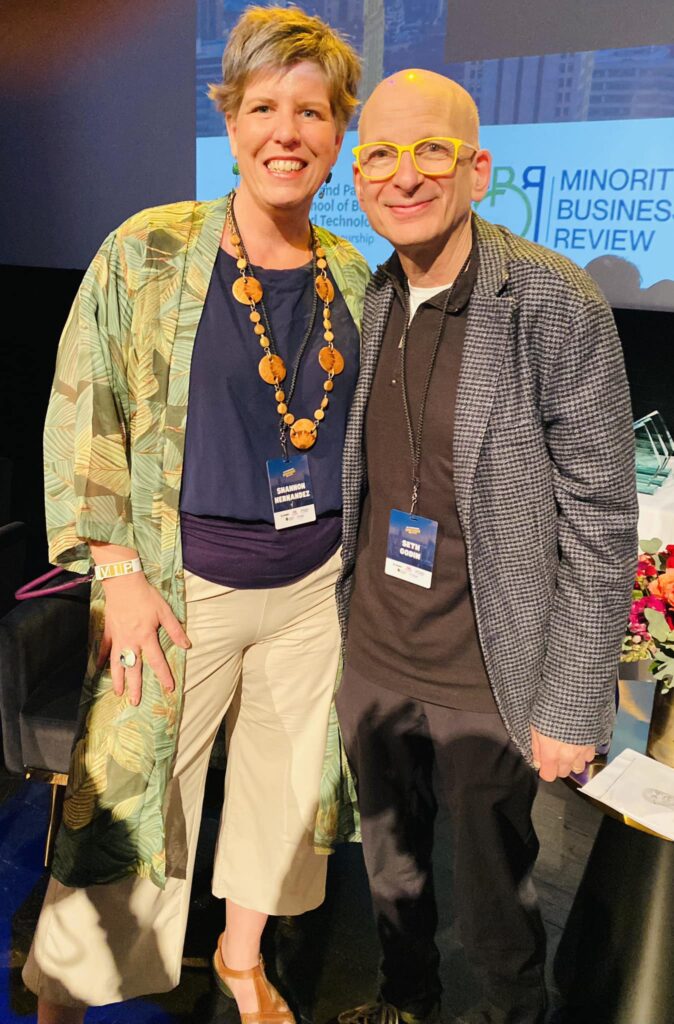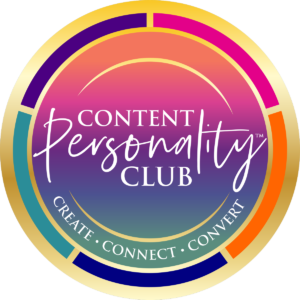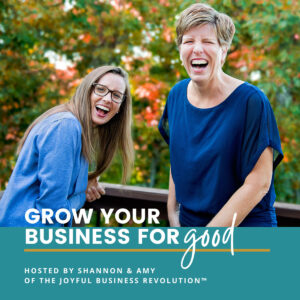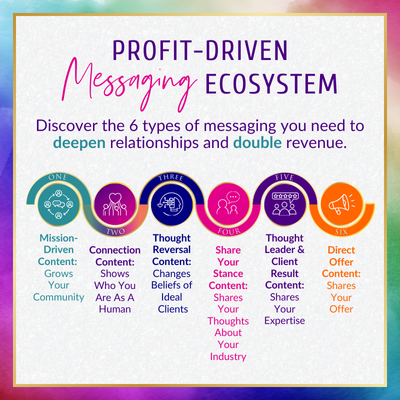Email nurture sequences can make the difference between a successful business and never getting out of hustle mode. That’s not to say that nurture sequences are magical things you can set and forget—plenty of work is still needed. However, your nurture sequence emails can help you grow relationships so you’re not burning yourself out pounding pavement or social media day in and day out.
Over the years, I’ve changed my approach to email nurture sequences. I used to write long nurture sequences. The emails weren’t long, but the sequences spread over weeks. However, with all the bro marketing techniques out there, I wanted to create something more human that nurtures real connections. The 4-part Human-Centric Nurture system is the result, and I’ll share more about that strategy below.
If you’re wondering who the Human-Centric Nurture System is for, I strongly feel anyone can adapt the email series for their business. Because Amy and I are strategists and consultants, ours is tailored for that particular audience. However, whether your business is B2B or B2C, one thing is true: the people on the other end are humans, and you’ve got to find a way to connect with them.
With that in mind, I want you to keep two things in mind as you create your email nurture strategy:
#1: The point of your nurture sequence should be to deepen your connections.
I am a huge advocate of email lists for many reasons, but it shouldn’t ever just be about growing a list for the sake of numbers. Your customers aren’t numbers—sure, you can talk about qualifying or scoring leads. But at the end of the day, you’re writing to humans. It follows that the best way to stand out is to treat them as such—and, in turn, be human.
#2: You should treat every email like a two-way conversation tool.
Conversations grow relationships, and relationships lead to sales. Your audience may want to learn from you. However, they probably don’t want to buy from you until they trust you and have a relationship with you. That means you’ve got to lay the groundwork for that relationship from the very first email (i.e. impression) they get from you.
Suffice it to say, your nurture sequence is a virtual handshake or a warm hug. When you get it right, you can start a conversation that lays the foundation for a thriving relationship.
There’s a good chance your email nurture sequence isn’t the first email automation you’ll write as part of your marketing strategy. What’s more, you might already have a nurture sequence, but this is your opportunity to ensure that your emails welcome your audience and move them towards your offer.
Finally, if you are using longer nurtures or wonder if you’re in the pushy bro marketer category, this isn’t meant to say you can’t use any of those techniques. But I believe there is a better way than bombarding people with dozens of emails. Amy and I made a choice to be more joyful and more human in every aspect of our business, including our marketing, because people and relationships are our top priority.
That means we want every experience people have with us to be joyful or, at a minimum, joy-led. Email nurture sequences play heavily into that intent.
Are Nurturing Sequences Effective?
Simply put, yes. Although this may seem like an obvious statement, I want to provide context.
These aren’t cold emails! Actual humans are raising their hands, saying, “Send me your knowledge and expertise!”
When they give you their email address, they’re telling you they want to get to know you and learn from you. Your nurture sequence provides an incredible opportunity to start conversations that are engaging and warm..
Your open and engagement rates are higher than any other email or sequence.
Our latest nurture sequence has an open rate of 90% and a click-through rate of 10%. For context, our typical emails range from an open rate of 40% and a click-through rate of 3-5%.
The “standard” varies by industry. However, for ease of comparison, opens average 34.2% and click-throughs 2.66%, respectively.
When your audience engages with you through conversations (replies) and clicks, you can stay in their inbox and out of spam or promotions folders.
What’s more, when you’re in their inboxes, more people read your emails and start to feel like they know you. The resulting relationships make people more likely to buy from you, even if it’s down the road—especially when you lean into your humanity.
Remember: engagement is a two-way street.
As you encourage people to connect with you and reply to your emails, someone has to be there to respond, whether that’s you or someone on your team. In our business, that’s either Amy, myself, or our Client Concierge VA, Jordyn. You always get an answer from an actual human, even though the nurture sequence comes through our marketing automation platform.
What Triggers Should I Use to Launch My Lead Nurturing Sequence?
If you’re asking this question, I want to turn it back on you—what are you doing to make actual humans want to raise their hands?
The starting point you use depends on your business. Some companies launch their sequences based on what pages people view or if they abandon their cart. However, most often, people hand over their email addresses in exchange for some kind of information, which might include:
- Case studies
- Survey or report results
- Webinars or pre-recorded videos
- Event waiting lists
- Quiz results
- PDFs and workbooks
We see a blend of these in just about every space and industry. For our business, we’ve used almost all of them to start growing relationships with our community. Reflection question for you: What lead generation tool has been most effective in our business?
Amy and I created our Content Personality® Quiz, which has consistently grown our email list by 20% quarter over quarter, adding people who feel they can benefit from our messaging and marketing experience and advice. We designed the quiz to help you understand how to use your natural strengths to create marketing content and maximize your time and energy. Take the quiz here!
Some of our other recent free lead generation tools have included our:
- Outline Your Organic Marketing Plan On-Demand Training: A four-step strategy to increase your visibility to new audiences.
- Our High-Value Facebook Group: Our community of business owners shares ideas and gets exclusive content from us.
- The Curiosity Lab is a mini 60-90-minute mastermind designed to help people stay curious about the next best step in growing their business.
- Behind the Scenes Podcast Recording: Over the course of an hour, people joined us on Zoom to watch us script and record an episode so they could see our process.
Whatever your trigger, you need email marketing automation software. Some popular, low-cost platforms don’t allow complex triggers or offer features like SMS marketing. Alternatively, not all features are available at all tiers, but you can upgrade. So, before you dive into your nurturing strategy headfirst, make sure you choose an email marketing platform that meets your needs.
I’d also encourage you to think ahead to your future needs. If you anticipate needing other features in the next few years, make sure they’re available even if at a different tier so your platform can grow with you. Once you get your sales funnel up and running, moving to a new marketing automation platform is a huge lift. While it’s far from the end of the world, I don’t advise platform hopping. The shift can mean a lot of time or money, paying someone else to do it for you.
So, what is the right nurture strategy? And what lead magnet should you use to trigger your lead nurturing email sequence?
If you find yourself stumped and asking these questions repeatedly, you don’t have to do it alone. Set up a call with Amy for help finding the best path forward.
Example Lead Nurturing Sequences
I’ve been salivating over writing this part of the article. Why? Several reasons—
#1: I’ve poured my heart and soul into the Human-Centric Nurture Sequence.
It reflects more than a decade of practice and testing to get the theory and structure just right.
#2: Email is my love language. I talk a lot about how it allows me to live my life offline. However, it goes beyond that. I love coming up with ways to nurture connections and grow relationships—and this is what I love teaching most.
The Human-Centric Nurture Sequence
As we played around with names for this strategy, I considered calling it the H2H Nurture Sequence, but it felt too cold and clinical for what we were setting out to do. It reduces Humans to an “H,” just like B2C reduces customers to a “C.”
Before I share it with you, a quick disclaimer: The Human-Centric Nurture Sequence isn’t the only nurture sequence out there, although I do think it’s the best for business owners who want to truly build a 2-way relationship from the start.
I want you to take what I’m sharing here and think critically about how you can adapt it to your business. And if you choose not to, I won’t come after you with my magic marketing wand (yes I have several sent to me by clients!) However, I am confident a human-focused approach is the best way to grow those connections—it allows you to turn your humanity into your greatest advantage.
The Human-Centric Nurture Sequence has 4 parts and lasts just 3 days.
Why 3 days?
I want people to be able to jump right into whatever the next valuable and fun thing Amy and I are hosting, instead of waiting 30 days for an extended nurture. And if they’re not ready to dive in right away, that’s fine, but I want to be sure we aren’t holding them up while we’re deepening that connection.
Email #1: The Delivery Email
What it is: An email that gives your audience access to whatever they signed up for and reminds them why they need to go do the thing.
Why it’s important: Your audience needs access to the goodies in their inbox so they can come back to them at any time. They also need a reminder about why they signed up.
When to send: Immediately after clicking “Subscribe!” or “Let’s go!” or “Send it to me!”
Engagement request: Click the link to get your freebie.
Email #2: The Introduction + Best Content
What it is: An email that introduces your audience to your mission, 2-3 pieces of your best, most valuable content, and why you do what you do every day.
Why it’s important: You want to make sure your audience knows they’re in the right place.
When to send: 2 to 3 hours after the last email.
Engagement request: Clicking on linked content.
Email #3: Newsletter Expectations
What it is: An email that reinforces your mission, shares how you communicate with people, and sets expectations for the newsletter.
Why it’s important: Make sure your audience knows what they have access to as a member of your community, even if your community is “just” your email list for now.
When to send: 24 hours after email #1.
Engagement request: Ask for a very specific reply. For example, we ask people to reply ALL IN FOR JOY and MONEY, so we know they feel good about being in our email community.
Email #4: Book a Call (or take a specific action)
What it is: We encourage people to take the next step with us. In our business, that means introducing them to Amy, explaining what’s in it for them to hop on a call with her, and then inviting them to book a call.
Why it’s important: It builds engagement, shares our Joy-Fueled Business Growth & Marketing Process, and gets them right to our offer, which is a free call—your offer doesn’t have to be paid
When to send: 24 hours after email #3.
Engagement request: Book a call (or whatever makes sense in your business).
As an added benefit, you only have to update the first email when you launch a new freebie. The other three usually stay the same unless you’re updating them across the board. Of course, you can adapt the second email based on a different “best” kind of content if your offer requires a slightly different touch. However, I love that you don’t have to—and that I don’t have to, either.
If you’d like to see the Human-Centric Nurture Sequence in action, I’d be happy to send it to your inbox.
The latest and greatest version is available when you download our new lead magnet, 65 Curated Story Marketing Ideas, designed to help you share your expertise with a clear, compelling message, so you can stand out in inboxes around the world.
Best Practices for Lead Nurturing Sequences
When it comes to writing great nurture sequence emails, there are a few best practices to keep in mind to keep your audience engaged and wanting to grow with you.
From Line
There’s really no wrong way to do this. The from line can come from your company name or from a person—you or someone on your team. Some people recommend one over the other. But whatever you choose, be consistent so your audience knows who is in their inbox. Our emails come from “Joyful Business Revolution.” Occasionally, they might come from me or Amy directly, but they won’t come from a random weird name like “Joyful Jennifer.” That would confuse our people, and we don’t want that.
Subject Lines
There are three main rules I follow:
- Short
- Sweet
- Clear
I always avoid clickbait headlines because I want people to know what they’re opening—and I want them to trust me. I also use the preheader or preview space to clarify even further. In the 65 Curated Story Marketing Ideas nurture, I include “[65 Curated Story Marketing Ideas]” in the preheader/preview section so people know exactly why they’re getting this email.
Email Length
Make your emails as long as they need to be, no longer. People are busy. They have lots of emails. Tell a story, absolutely. But save the 1,000-word essay for your blog. You can direct people to your blog posts, but offer a synopsis and let them dig deeper. If you want a specific target word count, shoot for 250-300 words. And if you need to go longer, make sure you have a good reason and that every word counts.
Personalization
Personalize your emails, but do it right. Make sure that instead of “Hi FNAME,” your personalization tags are spot on. If you decide to personalize further, your tagging and segmenting game has to be top-notch. After all, you don’t want someone to get an email saying, “It was so great to meet you in Phoenix,” if you met them in Chicago or haven’t met them at all. That’s the fastest way to turn email leads into unsubscribes.
Buttons or Links
I prefer links because they feel more personal than buttons. However, if you use buttons, shoot for no more than one button per email.
Clear CTAs
This goes back to clarity for overall email content. Make sure your audience knows what they’re getting when they click. Clarity is more compelling and increases the likelihood they’ll click.
Social Proof and Testimonials
Have a story people shared about why they loved your last event? Share that in your next sales sequence promoting an event or offer. But unless it’s about something super specific, the only email in your nurture series that should have any is email #4, where you invite them to take you up on an offer.
Follow the Law
Know the law and follow it. Most marketing automation tools force you to follow them, but in a nutshell, you’ll need to have an unsubscribe button and list your mailing address.
Track Your Results
This one is SO important. How do you know what’s working if you’re not keeping track of who is opening and clicking on your emails? We check every campaign that goes out. And if necessary, we follow up with people on a one-on-one basis. Yes, it can be time-consuming, but connecting with your people is the best way. And that personal touch can make all the difference when it comes to purchase time.
Be Human
“Humanism is your new advantage.” — Seth Godin.
Recently, I was lucky enough to share some time with Seth Godin. A considerable part of the conversation revolved around putting humanity back into marketing, especially in a time of AI. So be human. Share what sets you apart and what is uniquely you, starting with your nurture sequence.
Human-Centric Nurture Sequences are About Connection
I mentioned above that I wanted to set myself apart from the guru marketers. No one wants to get five emails after clicking on an ad before they have a chance to open the thing.
They may have raised their hands to get to know you, but that doesn’t mean they want a barrage of cold emails pushing them to buy, buy, buy.
That’s not human-centric. It’s why I trimmed my nurture sequence down to four emails in total. And I keep their experience and expectations in mind every step of the way. It doesn’t mean I don’t sell—I am in business after all. But, it means that the relationship comes first.
So keep in mind as you write your nurture sequences: your potential customers are busy, so they don’t always have a chance to look at your really great freebie as soon as they download it. Heck, your prospects might not have had a chance to download it yet—it might still be sitting “unread” or “starred” in their inbox. So, what experience do you want to leave them with? What do you want them to know about you? And what’s in it for them?
Start there, use our strategy for nurturing campaigns, and then stick to your email cadence. Then, watch everything come together for you as you grow email relationships like never before.
Wondering how to get started or how to turn your email newsletter into a relationship-building tool?
Others feel overwhelmed by figuring out what to write about, which is why Amy and I created the Content Personality® Club. We develop a monthly theme, gather in community, and help you create emails that deepen relationships and double revenue. Get the details here.
Would you like to dive deeper into email marketing–and how to make it work better for your business?
Season 5 of our podcast, Grow Your Business for Good, is all about email marketing and a great next step–if you enjoy listening to podcasts packed with value–and JOY!
You can also read more in this series on Email Marketing for Coaches and Consultants. You can find the entire series linked below: –
- The Art of Connection: An Email Marketing Playbook for Coaches
- How I Use Email Marketing to Fill Every Seat for In-Person Events
- Email Marketing Mastery for Webinar Hosts: Tips, Tricks, and Sequences
- The Business Benefits of Newsletters (+ When to Be Wary)
- Lead Nurturing Email Sequences: The What, the Why, and the How
- Best Email Marketing Platform for Solopreneurs [2024]

